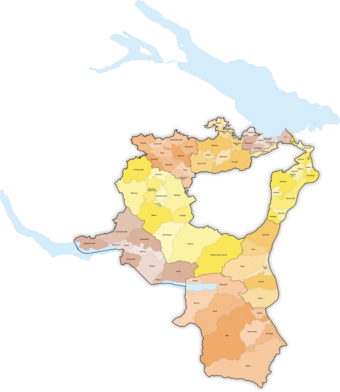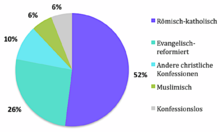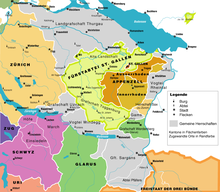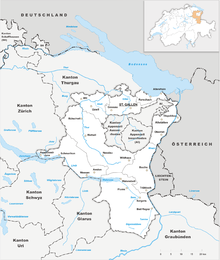Canton of St. Gallen
| Canton of St. Gallen | |
|---|---|
| coat of arms | |
| Canton of the Swiss Confederation | |
| Abbreviation / license plate : | SG |
| Official language : | German |
| Main town : | St. Gallen |
| Accession to the federal government : | 1803 |
| Area : | 2028.20 km² |
| Height range : | 392–3234 m above sea level M. |
| Website: | www.sg.ch |
| population | |
| Residents: | 507,697 (December 31, 2018) |
| Population density : | 250 inhabitants per km² |
|
Proportion of foreigners : (residents without citizenship ) |
23.5% (December 31, 2015) |
| Unemployment rate : | 2.7% (December 31, 2015) |
| Location of the canton in Switzerland | |
| Map of the canton | |
| Political municipalities of the canton | |
Coordinates: 47 ° 12 ' N , 9 ° 18' E ; CH1903: 741,029 / 229 345
The canton of St. Gallen ( Swiss-German Sanggale , French Saint-Gall , Italian San Gallo , Romansh ) is a canton in German-speaking Switzerland and is located in the Eastern Switzerland region . The main town is the city of the same name, St. Gallen .
geography
location
The eastern Swiss canton of St. Gallen borders the Swiss cantons of Graubünden , Glarus , Schwyz , Zurich , Thurgau , in the north on Lake Constance and in the east on the Austrian state of Vorarlberg and the Principality of Liechtenstein . Through Lake Constance , the Swiss canton borders indirectly on the districts of Constance , Lake Constance and Lindau in Germany . It also includes the half-cantons of Appenzell Innerrhoden and Appenzell Ausserrhoden .
Mountains and waters
The highest mountain in the canton is the Ringelspitz at 3247 m above sea level. M. , but the Säntis ( 2502 m above sea level ) is probably better known . The lowest point is Lake Constance at 395 meters above sea level. The largest lakes in St. Gallen are Lake Constance, Lake Zurich and Lake Walen , although they are not all located in the St. Gallen area. The largest lake exclusively in the St. Gallen area is therefore the Gigerwaldsee reservoir .
More important rivers are the Rhine , the Thur , the Linth , the Sitter and the Seez .
Regions
Geographical regions from north to south and from east to west.
population
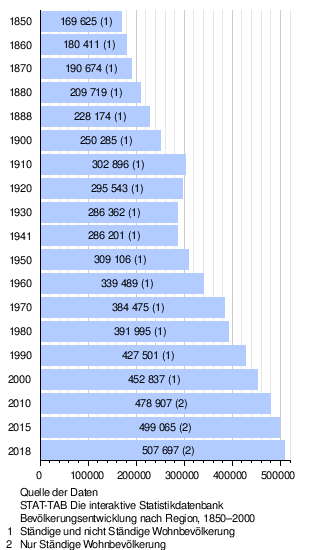
The inhabitants of the canton are called Sankt Gallen .
Demographics
As of December 31, 2018, the population of the Canton of St. Gallen was 507,697. The population density of 251 inhabitants per square kilometer is above the Swiss average (207 inhabitants per square kilometer). The proportion of foreigners (registered residents without Swiss citizenship ) was 23.5 percent on December 31, 2015, while 24.6 percent were registered nationwide. As of December 31, 2015, the unemployment rate was 2.7 percent compared to 3.7 percent at the federal level.
languages
The official language in the canton of St. Gallen is German , the colloquial language is Swiss German .
In 2012, 89.3 percent of the population stated German, 3.6 percent Italian and 1.2 percent French as their main language. No information was given on the other official Swiss language, Romansh . English was the primary language of 2.5 percent of the population.
Due to the heterogeneous composition of the canton as a result of the mediation act of 1803, there are different dialects in the canton of St. Gallen, including the Rheintaler, St. Gallen , Toggenburg or Sarganserland dialect.
Romansh was spoken in the southern regions of the canton of St. Gallen into the Middle Ages . For this reason, many geographical names (towns, fields, mountains, water) in this area are of Romanesque origin. The Swiss German dialects there still have a Romance accent today (Sarganserland and Werdenberg).
Nationalities
| Country of origin | 2000 | 2010 |
|---|---|---|
|
|
80.43 | 78.17 |
|
|
1.86 | 4.43 |
|
|
4.31 | 4.02 |
|
|
3.49 | 2.74 |
|
|
1.60 | 1.93 |
|
|
1.12 | 1.41 |
|
|
1.42 | 1.03 |
|
|
1.37 | 1.03 |
|
|
0.56 | 0.84 |
Religions - denominations
Historical background
Since the canton of St. Gallen was only created from different territories in 1803, it is denominationally very heterogeneous. The northern Fürstenland (once owned by the Prince Abbot of St. Gallen), with the exception of the traditionally reformed city of St. Gallen (once a free imperial city), and the southern parts of the canton (once subject areas of central Switzerland), including the Sarganserland, are purely Catholic . Toggenburg in the west is mixed, but predominantly Reformed, the Rhine valley in the east is also mixed, but predominantly Catholic (with the exception of the Reformed former Zurich and Glarus subject areas of Sax and Werdenberg ).
Today the Catholic denomination part of the canton of St. Gallen , the Evangelical Reformed Church of the canton of St. Gallen , the Christian Catholic church and the Jewish community of St. Gallen are recognized under public law.
Denomination statistics
As of December 31, 2017, 44.1 percent of the total population of the canton were Roman Catholic and 21.3 percent Protestant Reformed , while 34.6 percent belonged to another denomination / religion or were non-denominational . In the 2000 census, 52 percent of the canton's population were Roman Catholic, 26 percent Protestant Reformed, 10 percent belonged to other Christian churches, 6 percent were Muslim and 6 percent were non-denominational.
With the exception of the Roman Catholic and Reformed Churches, there have been no figures on the religious affiliation of the total population of the canton since the 2000 census . The Federal Statistical Office , however, carries out sample surveys in which other religious communities in the canton of St. Gallen are also recorded. In the 2017 sample survey, 7 percent of respondents aged 15 and over believed that they were of a different Christian denomination (neither Roman Catholic nor Reformed), 8 percent were Muslim and 1 percent belonged to another religious community. 18 percent of respondents aged 15 and over were non-denominational . Furthermore, the survey shows greater differences in terms of religious affiliation when the citizenship and origin of the respondents are considered:
| religion | Total of respondents |
Swiss State ality |
Swiss people without a migration background |
Swiss with a migration background |
Foreign heads of state ality |
|---|---|---|---|---|---|
| Christianity | 72 | 79 | 82 | 59 | 49 |
| - Roman Catholic | 44 | 48 | 50 | 35 | 32 |
| - evangelical reformed | 21st | 26th | 29 | 10 | 6th |
| - other Christian denominations | 7th | 5 | 3 | 14th | 11 |
| other religions | 9 | 3 | 1 | 20th | 26th |
| - Muslim | 8th | 2 | 0 | 16 | 23 |
| - other religious communities | 1 | 1 | 1 | 4th | 3 |
| non-denominational | 18th | 17th | 16 | 20th | 24 |
| no information | 1 | 1 | 1 | 1 | 1 |
See also: Diocese of St. Gallen .
State organization, politics
Constitution
The current cantonal constitution of the canton of St. Gallen is dated June 10, 2001 (with changes since then).
legislative branch
The legislative body ( legislature ) is the cantonal council , which has 120 members and is elected by the people for a fixed term of four years according to proportional representation.
The people who are entitled to vote also have a direct share in the legislation through referendums , i.e. mandatory referendums in the event of constitutional changes, optional referendums in the event of changes to the law, and popular initiatives for the adoption of constitutional or legal provisions. The vote on a law can require 4,000 voters; to propose a law requires the support of 6,000 voters; and to propose a constitutional amendment , 8,000 voters are required. Finally, 4,000 persons entitled to vote can demand general legislative activity ( unitary initiative ). The mandatory or optional referendum is then subject to government spending in the amount specified by law.
The composition of the Cantonal Council since the elections in the Canton of St. Gallen in 2016 is as follows:
| Political party | percent | Seats | Distribution of seats | Voting shares | |
|---|---|---|---|---|---|
| Swiss People's Party (SVP) | 29.63 | 40 |
Election to the St. Gallen Cantonal Council on March 8, 2020
Turnout: 32.72%
% 30th 20th 10
0
26.88
22.06
18.32
15.05
7.88
6.19
2.29
0.38
0.94
Gains and losses
|
||
| Christian Democratic People's Party (CVP) | 20.42 | 26th | |||
| FDP.The Liberals (FDP) | 20.31 | 26th | |||
| Social Democratic Party of Switzerland (SP) | 16.71 | 20th | |||
| Green Party of Switzerland (GPS) | 4.76 | 5 | |||
| Green Liberal Party (GLP) | 4.21 | 2 | |||
| Others | - | 1 |
The parliament meets in the so-called Palatine wing of the monastery courtyard in St. Gallen.
executive
The highest executive or executive body ( executive ) is the government , which has seven members with equal rights. They are elected by the people for a fixed term of four years according to the majority vote. The cantonal council elects the chairman, district president (until 2002 Landammann ), on a rotation basis for a one-year term of office.
The government councils of the current legislature from June 1, 2012 to May 31, 2016 (since the elections in the canton of St. Gallen 2012 ) and their respective departments are as follows:
| Government Council | Official title | Political party | department |
|---|---|---|---|
| Martin Klöti | District President | FDP | Department of the Interior |
| Heidi Hanselmann | Councilor | SP | Health Department |
| Benedict Würth | Government Council | CVP | Finance Department |
| Stefan Koelliker | Government Council | SVP | Education Department |
| Bruno Damann | Government Council | CVP | Department of Economic Affairs |
| Marc Mächler | Government Council | FDP | Building department |
| Fredy Fassler | Government Council | SP | Security and Justice Department |
State Secretary Canisius Braun (since 2009) is head of the State Chancellery .
Judiciary
The law ( judicial ) is at the Cantonal level by the Cantonal , commercial , administrative and insurance court applied.
At the regional level, there are first-instance district and labor courts as well as mediators as upstream conciliation authorities .
The court of cassation , until then the highest cantonal court, was abolished on January 1, 2011.
Administrative division
Political communities
As decentralized units, the canton of St. Gallen normally knows the political communities . Special communities are the local communities , the school communities as well as local and local civil corporations , the number of which, however, is decreasing from year to year and which consequently no longer exist in the entire canton. Although corporations under public law, the Roman Catholic and Protestant Reformed parishes are not "parishes according to parish law", but are organized according to regional church law .
As of January 1, 2017, the canton of St. Gallen comprised 77 political municipalities , 37 school municipalities , 98 local municipalities , 41 local corporations and 14 local civil corporations, a total of 297 “municipalities according to municipal law” and 57 special purpose associations.
Constituencies
Until the end of December 2002, the canton of St. Gallen was divided into districts . The tasks of the former districts have been increasingly transferred to other bodies in recent years; as an institution, the districts were finally abolished with the new cantonal constitution. Today's constituencies no longer perform state administration tasks.
Since January 1, 2003, the canton of St. Gallen has been divided into the following constituencies, which are listed in clockwise order:
Representation at national level
Like every full canton , St. Gallen sends two members to the Council of States and, due to its population, twelve members to the National Council .
External relations
The canton of St. Gallen maintains selected regional partnerships in Eastern and Central Europe as well as in Northern Italy:
-
 Liberecký kraj (Liberec Region), Czech Republic
Liberecký kraj (Liberec Region), Czech Republic
-
 Bihor County , Romania
Bihor County , Romania
-
 (former) Province of Udine , Italy
(former) Province of Udine , Italy
history
The canton of St. Gallen was created in 1803 by Napoleon Bonaparte at the request of the Helvetic MP Karl Müller-Friedberg . The area of the canton emerged from the merger of the Helvetic cantons Linth and Säntis minus the restored cantons Glarus and Appenzell. This "bankruptcy estate" consisted of the following areas (in terms of size):
- "Old Landscape" St. Gallen , until 1798 core area of the Prince Abbey of St. Gallen
- County of Toggenburg , ruled by the prince abbots of St. Gallen until 1798
- County of Sargans , until 1798 common rule of the Swiss Confederation
- Vogtei Windegg (Gaster) with the office of Gams , until 1798 common rule of the Swiss Confederation
- Vogtei Rheintal , until 1798 common rule of the Swiss Confederation
- County of Uznach , until 1798 common rule of the Swiss Confederation
- Werdenberg county , until 1798 a subject area of the Canton of Glarus
- Lordship of Sax-Forstegg , until 1798 subject area of the Canton of Zurich
- Rapperswil rule , until 1798 common rule of the Swiss Confederation
- City of St. Gallen , free imperial city and city republic until 1798
The newly formed canton of St. Gallen joined the Swiss Confederation as a federal member with equal rights in 1803, together with the other new cantons of Thurgau, Vaud , Aargau , Graubünden and Ticino . The briefly on the st. Gallic territory, the Helvetic cantons Linth and Säntis were dissolved.
The young canton adopted its first cantonal constitutions in 1803 and 1814 and was able to assert itself in the post-Napoleonic period against the territorial claims of the former prince abbot of St. Gallen, Pankraz Vorster , on the one hand and against separatist regions on the other.
In the constitution of 1814, due to the confessional heterogeneity of the canton, matters such as church, marriage and school matters were not handed over to the state, but to the Catholic and Reformed population groups, the so-called «cantonal parts», so that in addition to the general legislative Grand Council (today the Cantonal Council ) a Catholic and a reformed Grand Council were also introduced (→ confessional dualism ).
In 1831 a representative democratic constitution was introduced which, with the "people's veto ", already showed the first direct democratic features and replaced the previous oligarchic regime. In 1861, after violent disputes, the state took over the previously church school system. The strong denominationalization of the canton shaped St. Gallen well into the 20th century. In 1875 the “people's veto” was replaced by the optional referendum (the people's right to object to laws).
In the constitution of 1890, popular rights were modernized with the introduction of the people's initiative (right of the people to propose laws), the facilitation of the referendum and the popular election of the government. This Basic Law was valid, with many changes, until the current constitution of 2001 was passed, which primarily summarized the numerous constitutional innovations of the past hundred years and concluded the reorganization of the canton.
The right to vote and vote for women was introduced in St. Gallen in 1972 at the cantonal and communal level.
coat of arms
| Blazon : « In green a bundle of silver rods (fasces) with five visible rods and a right-turning silver ax with a thorn on the back. » | |
| Justification of the coat of arms: The coat of arms of St. Gallen shows a silver bundle of rods with hatchet in green (also called a bundle of lictors or, in Latin, fasces ). The origin of this bundle can be found in the Roman Empire . Lictors carried a bundle of rods with a hatchet in front of high officials. The bundle was considered a symbol of the judiciary. The color green is also visible in the coats of arms of the cantons of Thurgau and Vaud, also founded in 1803. |
In 2011 the form of the coat of arms was modified. The thorn of the ax was removed, the light green was changed to a dark one and the shape of the coat of arms was designed to taper downwards. Because of this, the blazon above is partially correct.
The revolutionaries in France adopted their symbols. In addition to the tricolor , the Helvetic Republic also adopted the bundle of rods. Compared to the French Marianne , Switzerland chose her Helvetia . After Napoleon Bonaparte founded the canton of St. Gallen, the bundle of rods was taken over and today shows the circumstances under which the canton was founded. The St. Gallen rod bundle has eight (five of which are visible) rods for the eight former districts of the canton at the time the canton was founded.
economy
- In 2011 the gross domestic product (GDP) per inhabitant was 72,486 Swiss francs .
- In 2012 there were 285,210 employees in the canton of St. Gallen, of which 11,696 were in the primary (primary production) , 87,948 in the secondary (industry) and 185,566 in the tertiary sector (services) .
- In 2017, around 269,000 residents of the canton of St.Gallen were gainfully employed.
- There were 37,012 workplaces in the canton in 2012 (of which 4,428 in the primary, 6688 in the secondary and 25,896 in the tertiary sector).
- The unemployment rate amounted at 31 December 2015 2.7 percent compared to 3.7 percent at the federal level.
Half of the total area in the canton is used as agricultural land. Until around 1920, the textile industry was by far the most important branch of industry in the St. Gallen economy .
The most important company in the canton is the building materials group LafargeHolcim , based in Rapperswil-Jona . In 2018, the group was 14th on the list of the largest companies in Switzerland . Other important companies are Bühler AG , Geberit , SFS , Debrunner Koenig Holding , Leica Geosystems and Maestrani .
traffic
As every year with road and rail traffic , numerous accidents with wildlife occurred again in 2018 . In the canton of St. Gallen, at least 421 red foxes , 326 deer , 186 badgers , 126 beech martens and various other species fell victim to traffic.
Public transport
Several long-distance lines of the Swiss Federal Railways run through the canton. The most important hub in the canton is the St. Gallen train station , followed by the Wil , Rapperswil , Ziegelbrücke , Sargans or Heerbrugg train stations .
The backbone of regional traffic in the canton of St. Gallen then forms the S-Bahn St. Gallen , which is operated by the Thurbo , the Südostbahn and the Appenzeller Bahn . The Postbus , the VBSG , private bus companies, the Unterterzen-Tannenbodenalp cable car and the ship company to Quinten provide regional and local transport services on behalf of the canton or commune . All public rail and bus companies operating in the canton of St. Gallen are members of the Ostwind tariff association .
Shipping takes place on Lake Walen and Lake Constance.
Private transport
The national road network completed in the canton of St. Gallen ensures the connection to the rest of Switzerland; The only thing left is a better connection to neighboring Austria. The cantonal road network with a total length of approximately 675 kilometers covers cantonal and regional needs. Links within the communities or less significant links between communities are the responsibility of the political communities.
In 2019, the degree of motorization (passenger cars per 1000 inhabitants) was 557. The cantonal civil engineering office maintains a specialist unit for non- motorized traffic . However, the municipalities are primarily responsible for non-motorized traffic (pedestrian, hiking and cycle path networks).
towns and places
Listed below are the most populous of the 77 political communities with more than 10,000 inhabitants as of December 31, 2018:
| Political community | Residents |
|---|---|
| St. Gallen , capital | 75,833 |
| Rapperswil-Jona | 26,999 |
| Wil | 23,966 |
| Gossau | 18,173 |
| Uzwil | 12,892 |
| Box | 12,661 |
| Altstätten | 11,733 |
| Flawil | 10,523 |
Other municipalities with known localities are:
| Political community | Residents |
|---|---|
| Rorschach | 9441 |
| Wattwil | 8740 |
| Uznach | 6417 |
| Sargans | 6133 |
| Bad Ragaz | 6102 |
| Wildhaus-Alt St. Johann | 2626 |
See also
literature
- Wolfgang Göldi, Regula Steinhauser-Zimmermann, Alfred Zangger, Max Baumann, Max Lemmenmeier: St. Gallen (Canton). In: Historical Lexicon of Switzerland .
- St. Gallen history 2003 in 9 volumes. St. Gallen 2003.
- Various authors: St.Gallerland . Teaching material for the 4th to 6th grade. Ed .: Education Council of the Canton of St. Gallen. Lehrmittelverlag St. Gallen, St. Gallen 2009, ISBN 978-3-906784-37-3 .
Web links
|
Further content in the sister projects of Wikipedia:
|
||
|
|
Commons | - multimedia content |
|
|
Wiktionary | - Dictionary entries |
|
|
Wikisource | - Sources and full texts |
|
|
Wikinews | - News |
|
|
Wikivoyage | - Travel Guide |
References and comments
- ↑ Balance of the permanent resident population by canton, definitive annual results, 2018. Federal Statistical Office (FSO), August 27, 2019, accessed on September 18, 2019 (definitive annual results).
- ↑ Structure of the permanent resident population by cantons. Federal Statistical Office (FSO), August 26, 2016, accessed on May 31, 2017 .
- ^ The situation on the job market in December 2015. (PDF; 807 kB) State Secretariat for Economic Affairs (SECO), January 8, 2016, p. 9 , archived from the original on January 12, 2016 ; accessed on January 13, 2016 .
- ↑ Geography and Climate. (No longer available online.) St. Gallen State Chancellery, archived from the original on December 30, 2010 ; Retrieved June 26, 2008 . Geography and Climate ( Memento from December 30, 2010 in the Internet Archive )
- ^ STAT-TAB: The interactive statistics database, population development by region, 1850–2000. Swiss Confederation, accessed on January 7, 2014 .
- ↑ STAT-TAB: The interactive statistics database, population status. Swiss Confederation, accessed on June 19, 2017 .
- ↑ Balance of the permanent resident population by canton, definitive annual results, 2018. Federal Statistical Office (FSO), August 27, 2019, accessed on September 18, 2019 (definitive annual results).
- ↑ Structure of the permanent resident population by cantons. Federal Statistical Office (FSO), August 26, 2016, accessed on May 31, 2017 .
- ↑ a b The situation on the labor market in December 2015. (PDF; 807 kB) State Secretariat for Economic Affairs (SECO), January 8, 2016, p. 9 , archived from the original on January 12, 2016 ; accessed on January 13, 2016 .
- ↑ a b key figures. St. Gallen. (No longer available online.) Federal Statistical Office (FSO), archived from the original on August 22, 2015 ; accessed on August 16, 2015 .
- ^ Maximilian Wilhelm Götzinger 1891: The Romanic place names of the canton of St. Gallen. Online (PDF; 4.1 MB)
- ↑ Population - basic key figures for the canton of St.Gallen. (PDF; 405 kB) Statistical Office for the Canton of St. Gallen, accessed on March 1, 2012 .
- ^ Canton of St. Gallen: Preliminary advisory commission on the law on religious communities. March 15, 2018, accessed June 3, 2020 .
- ^ Department for Statistics Canton St. Gallen (STADA2 statistics database): Denomination - Canton St. Gallen (indicators). June 3, 2020, accessed June 3, 2020 .
- ↑ Federal Statistical Office: Canton of St. Gallen: Resident population by main language, religion, nationality and other characteristics, VL 2000. (XLSX; 95 kB) January 9, 2013, accessed on June 3, 2020 .
- ↑ a b Since 2010, the data from the Federal Statistical Office on the religious communities in the canton of St. Gallen have been based on a sample survey for which people aged 15 and over are surveyed. It should be noted that the results of the surveys show a confidence interval. Since the last census in 2000, there are no more figures on the religious affiliation of the total population (of all ages) for the canton of St. Gallen. Exceptions are the Roman Catholic and Evangelical Reformed Churches, whose members are officially registered on the basis of church tax .
- ↑ Federal Statistical Office: Permanent resident population aged 15 and over by religious affiliation and canton, 2017. (XLSX; 377 kB) 2019, accessed on June 3, 2020 .
- ^ Constitution of the Canton of St. Gallen. In: admin.ch . Federal Chancellery (BK), accessed on August 16, 2015 .
- ^ Government of the Canton of St.Gallen. Office year from June 1, 2016 to May 31, 2017. St. Gallen State Chancellery, accessed on June 20, 2016 .
- ^ Office for municipalities. State Chancellery St. Gallen, December 11, 2015, accessed on January 17, 2016 .
- ↑ partner regions. State Chancellery St. Gallen, accessed on October 16, 2018 .
- ↑ Meyers Enzyklopädisches Lexikon, 1977, Volume 20, p. 686.
- ^ Mühlemann, Louis, Wappen und Fahnen der Schweiz, 700 years Confoederatio Helvetica, Lengnau, 1991, 3rd edition
- ↑ Employed persons, employees, jobs. Canton of St.Gallen, accessed on January 21, 2020 .
- ↑ Source: Statistics for the EUREGIO Lake Constance. In: Listed! The ten districts of the Lake Constance region… In: Südkurier from February 25, 2011 and in: Ders. dated July 2, 2011
- ^ Canton of St. Gallen: Record damage from wild boars. In: sg.ch. April 18, 2019, accessed April 18, 2019 .
- ↑ bfs.admin.ch
- ↑ Permanent and non-permanent resident population by year, canton, district, municipality, population type and gender (permanent resident population). In: bfs. admin.ch . Federal Statistical Office (FSO), August 31, 2019, accessed on December 22, 2019 .



